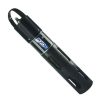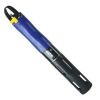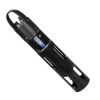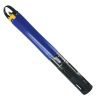YSI EXO NitraLED UV Nitrate Sensor
Features
- Available at a fraction of the cost of other lamp-based nitrate sensors
- Built-in corrections for natural organic matter (NOM) and turbidity
- Designed for use with EXO1, EXO2, EXO3, or EXO2s water quality sondes
- Expedited repair and warranty service
- Lifetime technical support
- More
| Accuracy |
± 0.1 mg/L–N or 5% of reading, w.i.g. (within 2°C) |
|---|---|
| Depth Rating | 250 m |
| Drift / Stability |
≤ 0.2 mg/L–N |
| Equipment used with | EXO™ |
| Light Source | UV LED (x2) |
| Lower Detection Limit |
0.005 mg/L–N |
| Measurement Range |
0-10 mg/L–N |
| Medium |
Fresh water |
| Nominal Wavelengths | 235 nm, 275 nm |
| Operating Temperature | 5-35°C |
| Pathlength | 10 mm |
| Precision |
≤ 2% Coefficient of Variation (CV) |
| Response Time | T95 < 30 seconds |
| Sensor | Optical, absorbance |
| Storage Temperature | -20-80 °C |
| Warranty |
2 years |
- YSI EXO NitraLED UV Nitrate Sensor Specifications
- YSI EXO NitraLED UV Nitrate Sensor Corrections for Turbidity and NOM
- YSI EXO NitraLED UV Nitrate Sensor Site Specific Correction Procedure
- YSI EXO NitraLED UV Nitrate Sensor Installation Guide
- YSI EXO Water Quality Sonde Specifications
- YSI EXO Water Quality Sonde Manual
In The News
Sewage an Unseen and Ignored Threat to Coral Reefs and Human Health
It’s an open, dirty secret that the ocean is used as the ultimate sewage solution. Each year trillions of gallons of untreated waste are sent to the ocean due to a widespread lack of sanitation technology or infrastructure that needs updating as cities and populations grow. As the impact of untreated sewage on the ocean becomes clearer, attention to the problem and strategies for dealing with it have not kept up. “This is a massive problem and it’s been largely ignored,” said Stephanie Wear, senior scientist and strategy advisor for The Nature Conservancy. Wear has turned her attention to raising the alarm about the effects of sewage on coral reefs, which often loses airtime to other pressing issues like climate change and overfishing.
Read MoreApplied Research and Innovative Solutions: Creating CHNGES at Western Kentucky University
Long-standing environmental monitoring programs have the power to support a large number of research initiatives and policy changes—however, actually starting these networks can prove challenging. Not only is starting the program difficult, but keeping things operational for decades to come has also been challenging for environmental professionals hoping to make an impact with applied research. Jason Polk, Professor of Environmental Geoscience and Director of the Center for Human GeoEnvironmental Studies (CHNGES) at Western Kentucky University, is all too familiar with this process.
Read MoreCombating Water Insecurity in Saskatchewan with Real-Time Data
The prairies of Saskatchewan can be described as one of the least water-secure parts of Canada, making water quality monitoring essential for informed resource management in a region already facing water insecurity. While natural physical properties worsen some of the poor water quality conditions in the region, others are connected to land use. Having grown up spending summers on the shores of Lake Huron, Helen Baulch, an associate professor at the School of Environment and Sustainability at the University of Saskatchewan , has always been dedicated to the protection of water resources. Looking back fondly at her childhood playing along the shore, Baulch also recalls the invasion of quagga mussels during her teenage years and watching the lake change as a result.
Read More















